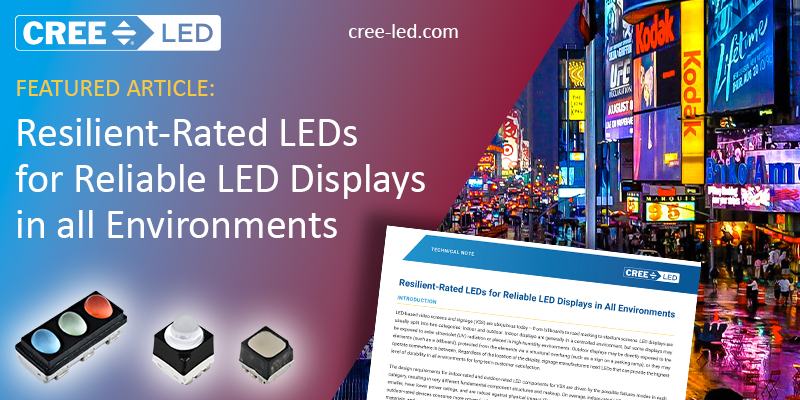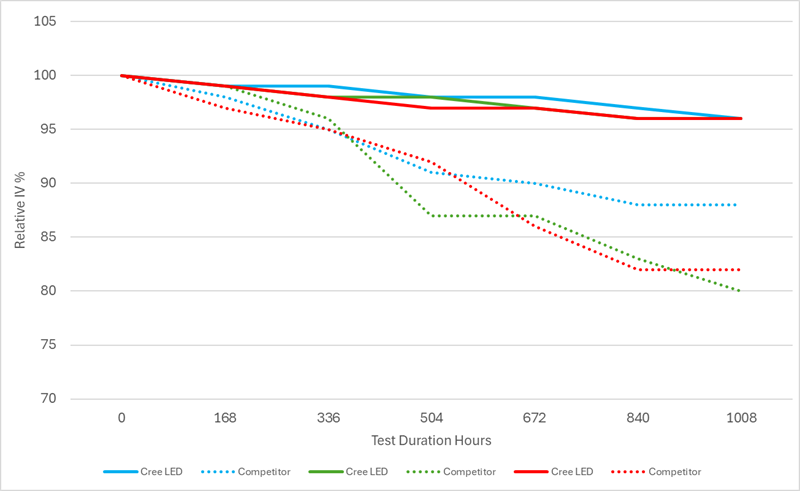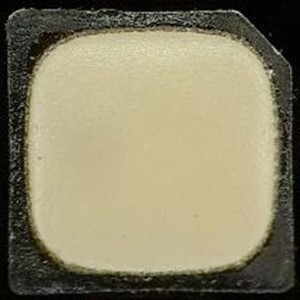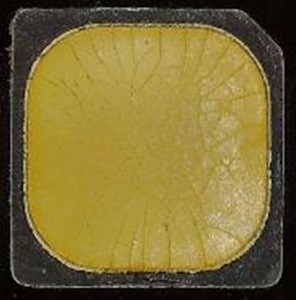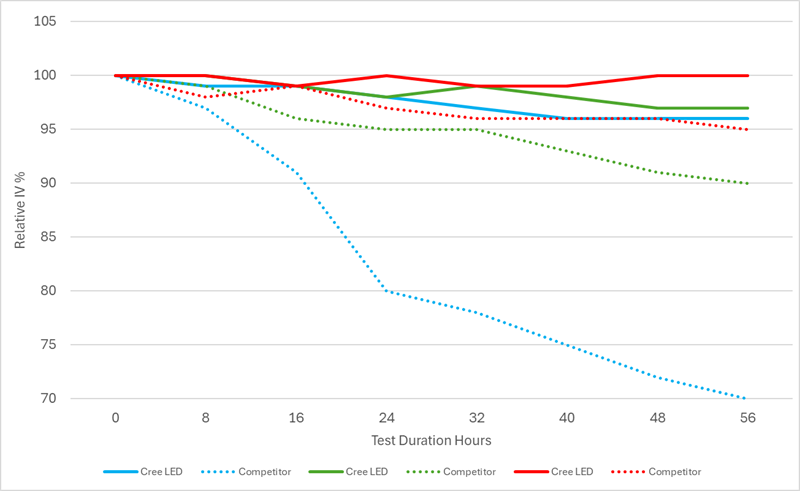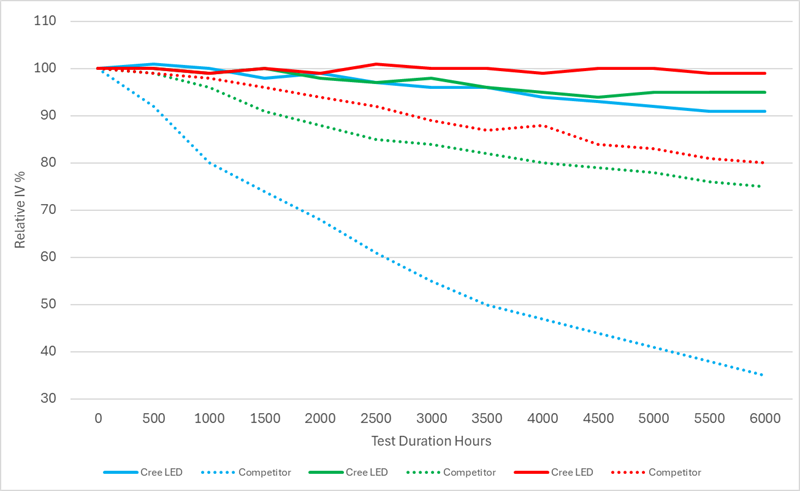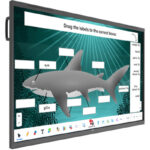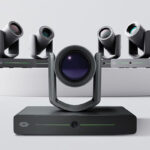LED-based video screens and signage (VSS) are ubiquitous today – from billboards to road marking to stadium screens. LED displays are usually split into two categories: indoor and outdoor. Indoor displays are generally in a controlled environment, but some displays may be exposed to solar ultraviolet (UV) radiation or placed in high-humidity environments. Outdoor displays may be directly exposed to the elements (such as a billboard), protected from the elements via a structural overhang (such as a sign on a parking ramp), or they may operate somewhere in between. Regardless of the location of the display, signage manufacturers need LEDs that can provide the highest level of durability in all environments for long-term customer satisfaction.
The design requirements for indoor-rated and outdoor-rated LED components for VSS are driven by the possible failures modes in each category, resulting in very different fundamental component structures and makeup. On average, indoor-rated LED devices are generally smaller, have lower power ratings and are robust against physical impact (for example, a child touching a video screen). In contrast, outdoor-rated devices consume more power (with a higher power rating) to overcome daytime light, include waterproofing designs and materials, and employ additives to mitigate damage from salt, chemicals and UV light exposure.
Until the mid-2010s – when Cree LED launched the first outdoor-rated SMD – outdoor VSS installations required substantial investments outside of the LED component in structural waterproofing and protection against the elements. With the launch of the CLY6 ultra-contrast LEDs, Cree LED simplified the design and installation of outdoor displays with patented technology that enabled a new era of high resolution and high reliability displays that were simpler and cheaper to manufacture. Over the past decade, Cree LED has spent millions of R&D dollars to expand this class of LEDs to different sizes and performance levels, resulting in an industry-leading portfolio of display LEDs that we call resilient rated.
However, the LED industry is currently filled with components that claim to be “outdoor rated” but lack the design and materials needed to actually survive the rigors of an outdoor installation for any length of time. Even more concerning is the increasing frequency of “copycat” LED components manufactured to look like a Cree LED component that do not include the materials and design engineering required to last like our resilient rated components.
This article covers the basic design considerations of resilient rated LED components and demonstrate the difference between our LEDs and other “outdoor rated” components. Industry-known test protocols are described and presented in a relatively surface-level way for both ease of understanding and to protect the nuances of the Cree LED suite of test protocols.
Key Areas of VSS LED Component Design
Each of the following sections focuses on the different requirements or design considerations that Cree LED uses to determine if a component is qualified as resilient rated. Comparisons between Cree LED’s CLY6 resilient rated LEDs and competitor “outdoor rated” LEDs that are similar in rated power and size are presented in each section. Each section concludes with a statement on the acceleration factor of the presented test to give the reader a sense of how the test relates to performance in a real-world application.
Acceleration factor is simply the ratio of represented real-world hours divided by the test protocol duration at matched performance. For example, if a testing protocol requires an LED component to be on test for 100 hours and the optical performance of that part matches the same part in a real-world application at 1000 hours, the test protocol would have an acceleration factor of 10 (1000 / 100).
Thermal Cycling
Many outdoor signs are placed in an area where the ambient temperature swings 15 °C or more throughout the day, acting as a constant stress on many aspects of the sign itself. Structural pieces, solder joints, connections and waterproofing features of a sign must be engineered to survive this expansion/contraction cycle. Equally important – the inner workings of LEDs do not have an exception from this requirement. A resilient rated LED must be able to survive the daily thermal cycle in addition to the thermal load from operating the sign – meaning that the individual red, green and blue chips within the LED will see maximum temperatures in the 85 °C to 115 °C range along with a 60 °C (or more) temperature differential between being on during the daytime and off or dimmed during the night.
During product development, Cree LED puts our SMD components through a rigorous thermal testing protocol to mimic the thermal profile experienced during real-world operation. In addition to standard operating life tests, thermal testing protocols include thermal shock (rapid changes in ambient temperature), thermal cycling (changes in temperature while the LEDs are energized) and solar irradiation combined with thermal cycling. A typical thermal shock test will rapidly cycle the LED between two ambient temperatures with a very wide temperature range, with an industry standard accepted range of approximately 100 °C and a cold temperature minimum of 0 °C. As part of its qualification process, Cree LED pushes the devices to the thermal limits with a minimum temperature delta of 140 °C. Figure 1 shows a comparison of thermal shock test results of a resilient rated Cree LED device and a competitor device that claims to be similar, with individual blue/green/red channels shown as colored lines. The competitor’s device fails our qualification test due to the significant intensity degradation that happens in such a short time.
Figure 1: Example thermal shock test protocol performance comparing the Cree LED CLY6 part with a competitor’s part that claims to be similar. Lines are colored by the red/green/blue channel they represent in each device.
The accelerated thermal shock test in Figure 1 highlights the construction quality differences between these two packages almost immediately, as the competitor parts quickly exhibit delamination and cracking failure modes at multiple interfaces within the device. When any interface is compromised in an outdoor application, moisture quickly penetrates the device and accelerates the aging process, eventually leading to premature part failure. Thermal shock is an excellent protocol to employ to understand package-level robustness and interfacial adhesion, with an acceleration factor in the 10x to 50x range depending on the temperature tuning of the test.
Displays that use the competitor devices will get dimmer much faster and suffer much higher LED failure rates than if they used Cree LED’s resilient rated LEDs. In addition, the intensity degradation of each color channel in the competitor device is not uniform, which will cause the display to shift color balance away from the initial calibration. Cree LED’s resilient rated devices show much better reliability while maintaining a consistent color balance and reducing the need to recalibrate the display.
UV Exposure
With approximately 5% of the spectral radiation from the sun residing in the UV spectral window, UV protection for outdoor-rated LED components is critical for long-term operation. When the LED components do not provide sufficient UV protection, the screen manufacturer is required to apply either a protective coating (some form of inorganic oxide, radical scavenger, or nanoparticle material) or install a solid filter in front of the screen. Both of these solutions add cost and weight, reduce brightness and contrast and require additional maintenance over time. When UV protection is not included in the design of an outdoor LED component, cracking and discoloration quickly occur, followed by moisture penetration and device failure.
Cree LED resilient rated components are designed with UV protection in mind by using UV resistant base materials as well as employing protective coatings and/or UV absorbers. These products undergo a series of specific UV tests including a multi-month test suite with exposure to elevated UV radiation levels (as compared to the typical solar radiation at the equator) and a high temperature and humidity solar aging test.
Figure 2: Example images of two devices post the UV exposure test. On the left is the outdoor qualified Cree LED CLY6 part and on the right is an internal control part with no UV protection included.
Figure 3 compares the accelerating UV testing results of the Cree LED CLY6 against the same competitor device used in the previous thermal shock section. The lack of UV protection in the competitor’s device quickly results in discoloration of the clear epoxy encapsulation and a decrease in the amount of light exiting the package. This discoloration is further promoted by the increased thermal stress due to more light being absorbed by the discolored package material, leading to a feedback loop that results in device failure.
Figure 3. Accelerated UV aging with humidity test performance comparing the Cree LED CLY6 with a competitor part that claims to be similar. Lines are colored by the red/green/blue channel they represent in each device.
Acceleration factors for the UV testing protocols range from 50x to 1000x depending on the UV dosage. Cree LED’s most accelerated test includes both humidity and UV aging, highlighting long-term material degradation in just 8 weeks.
Displays using the competitor LED in direct sunlight will experience a rapid drop in screen brightness, as well as a quick color shift away from blue as the lens changes color. Attempts to rebalance this screen’s color will only result in further drops in screen brightness as the green and red channels must be turned down to match the dim blue channel. Furthermore, it will be almost impossible to replace parts of the display since the output and color balance of new components will be much different than the installed components. All of these issues could have been avoided by choosing Cree LED’s resilient rated LEDs, which deliver superior reliability and require much less maintenance.
Element Resistance: Rain, Wind, Hail, Salt
For over a decade, Cree LED has developed and patented many advancements related to elemental resistance and waterproofing, resulting in the industry’s most highly resilient and durable LEDs. Ingress Protection (IP) standard ratings are a key piece of the qualification that Cree LED performs on its resilient rated LEDs. IP ratings are a standardized system used to define the level of protection an electronic enclosure provides against the intrusion of solid objects, dust and water as defined by the International Electrotechnical Commission (IEC). For outdoor LED displays, IP ratings are crucial as they determine the screen’s ability to withstand harsh environmental conditions, such as rain, dust, chemicals and cleaning solutions. The IP rating consists of two digits: the first digit indicates the level of protection against solid objects (dust, dirt, animal debris) and the second digit indicates the level of protection against liquids. The most common IP ratings for LED devices designed for VSS applications are:
IP65 Protected against dust (first digit 6) and low-pressure water jets from any direction (second digit 5). Suitable for most outdoor environments.
IP66 Protected against dust (first digit 6) and strong water jets from any direction (second digit 6). Ideal for areas with heavy rain or high-pressure water exposure.
IP67 Protected against dust (first digit 6) and immersion in water up to 1 meter deep for up to 30 minutes (second digit 7). Suitable for temporary submersion in water.
IP68 Protected against dust (first digit 6) and continuous immersion in water beyond 1 meter (second digit 8). Ideal for permanent submersion in water.
Selecting the appropriate IP rating for an outdoor LED screen depends on the specific environmental conditions it will face. However, a minimum rating of IP66 is necessary for a cost-effective installation of an outdoor LED screen due to the cost of panel replacement over time for an IP65-rated device. All Cree LED resilient rated LEDs pass testing for both the IP68 immersion rating for protection against dust and water ingress, as well as the IP66 rating for protection against high-pressure water jets.
Cree LED employs several different testing methods to gauge a device’s resistance to the elements, including high-temperature high-humidity WHTOL (wet high-temperature operating life) long-term testing, salt spray, underwater immersion testing, storage under humidity and a suite of proprietary tests that combine the introduction of water and/or humidity into other test protocols. Figure 4 presents the results of WHTOL testing for the Cree LED CLY6 and a competitor part that claims to be similar.
Specifically, this test subjects the devices to both elevated temperatures and very high humidity (85 to 90%) while the devices are biased, resulting in a very real-world applicable protocol.
Figure 4: High-temperature high-humidity test performance comparing the Cree LED CLY6 part with a competitor part that claims to be similar. Lines are colored by the red/green/blue channel they represent in each device.
The competitor device fails this test quickly, driven by the encapsulation material separating from the package and water entering the device. Like the previous UV testing protocol discussion, this behavior results in a feedback loop that can eventually result in complete delamination of the encapsulation material from the device. The acceleration factor for this high-temperature high-humidity test ranges from 5x to 20x depending on the VSS installation site and conditions.
Once again, outdoor displays built with this competitor LED will see a large amount of pixel failures, as well as very noticeable drops in screen brightness. All these issues will result in premature warranty claims, as well as expensive maintenance visits, and could have been avoided by choosing Cree LED’s higher reliability components.
Cleaning and Power Washing
Cleaning is an essential aspect of outdoor screen maintenance, performance, and longevity and can be one of the larger expenses related to the VSS installation, depending on the installation height and location. The IP ratings discussed in the previous section are applicable here. Any outdoor-rated LED part for VSS applications must be resilient to pressure washing within the IP protocol. It is common in the industry to see data sheets or term sheets for supposed “outdoor-rated” LED parts that limit or outright restrict power washing as part of the warranty terms — this is a big red flag for the long-term performance of these devices. All resilient rated LED components from Cree LED can and should be power washed according to industry standards.
Resilient Rated
Designing and selecting products for a VSS application is a complex process that extends well beyond the LED device itself. However, by choosing LEDs that inherently meet the requirements for high-quality VSS installations, system design can be simplified, resulting in an improved user experience, potentially lower upfront system and installation costs, and reduced lifetime maintenance expenses. Cree LED offers a comprehensive suite of products for VSS applications, each rigorously tested and qualified to withstand even the harshest installation environments. For more information on the testing protocols and the test results on our components, please contact your Cree LED sales representative.

